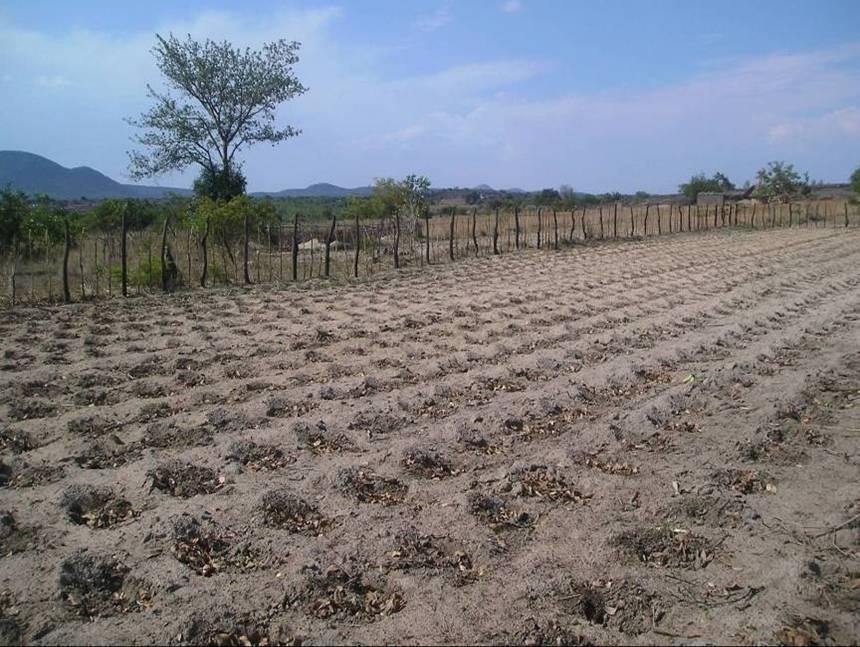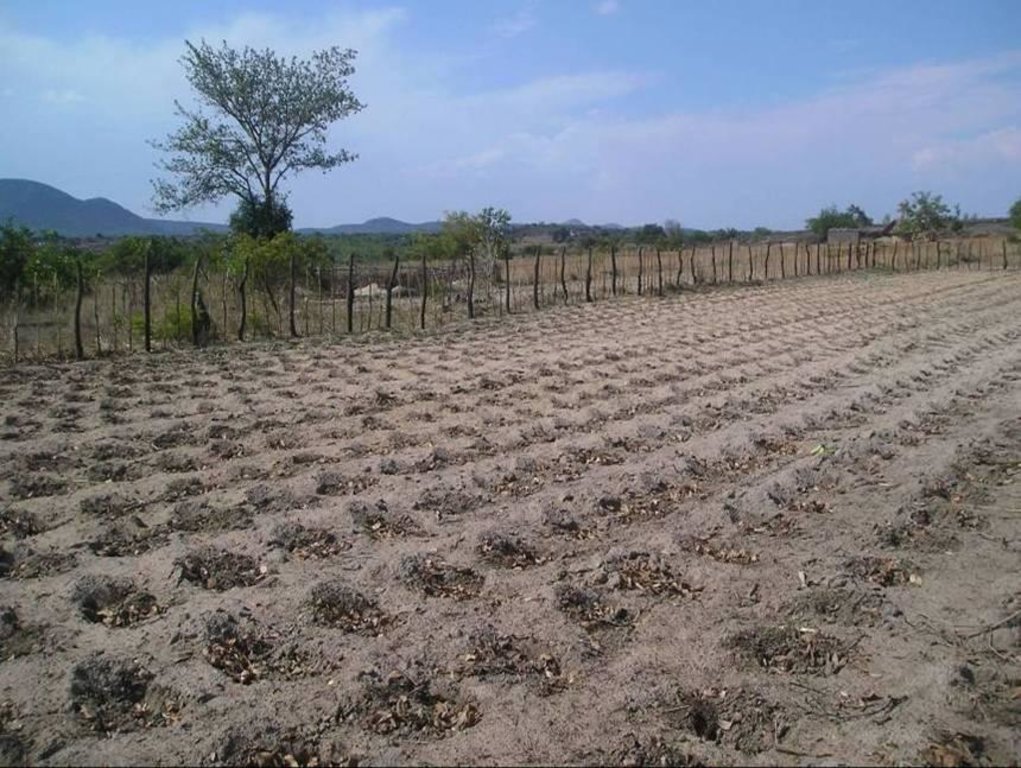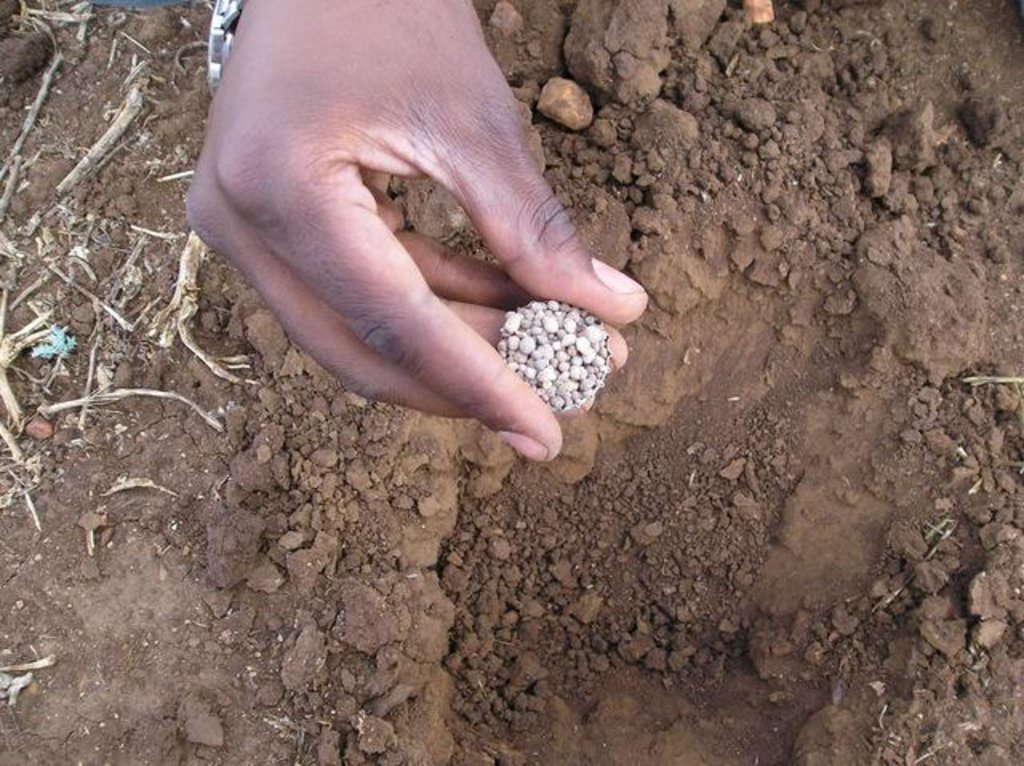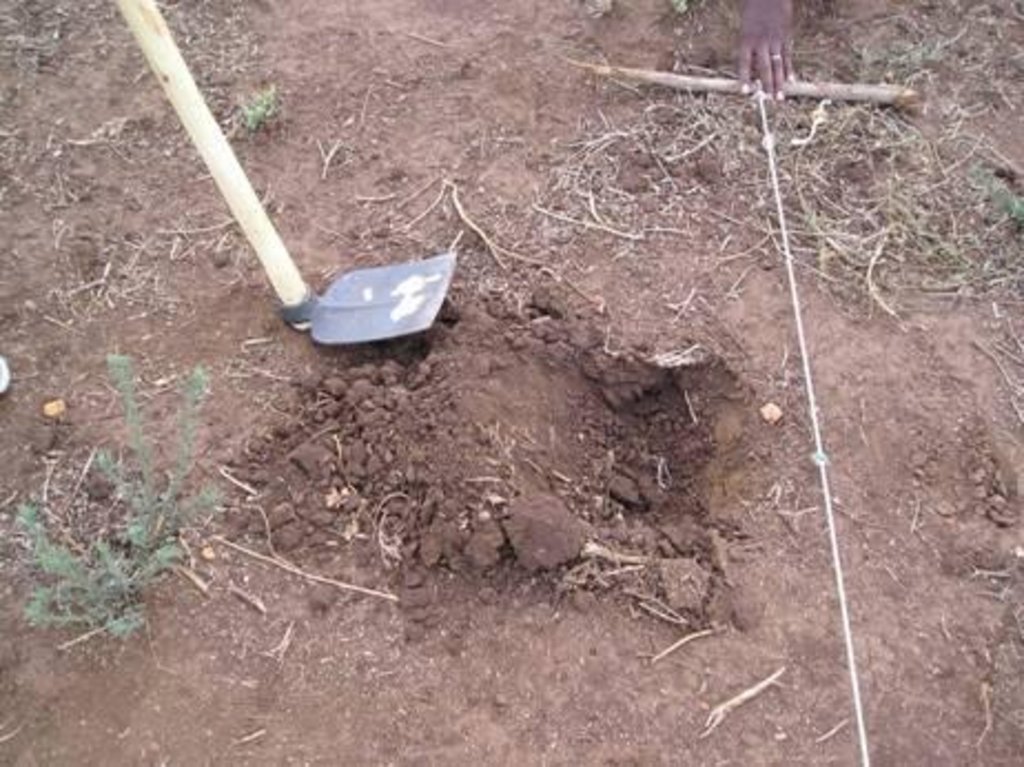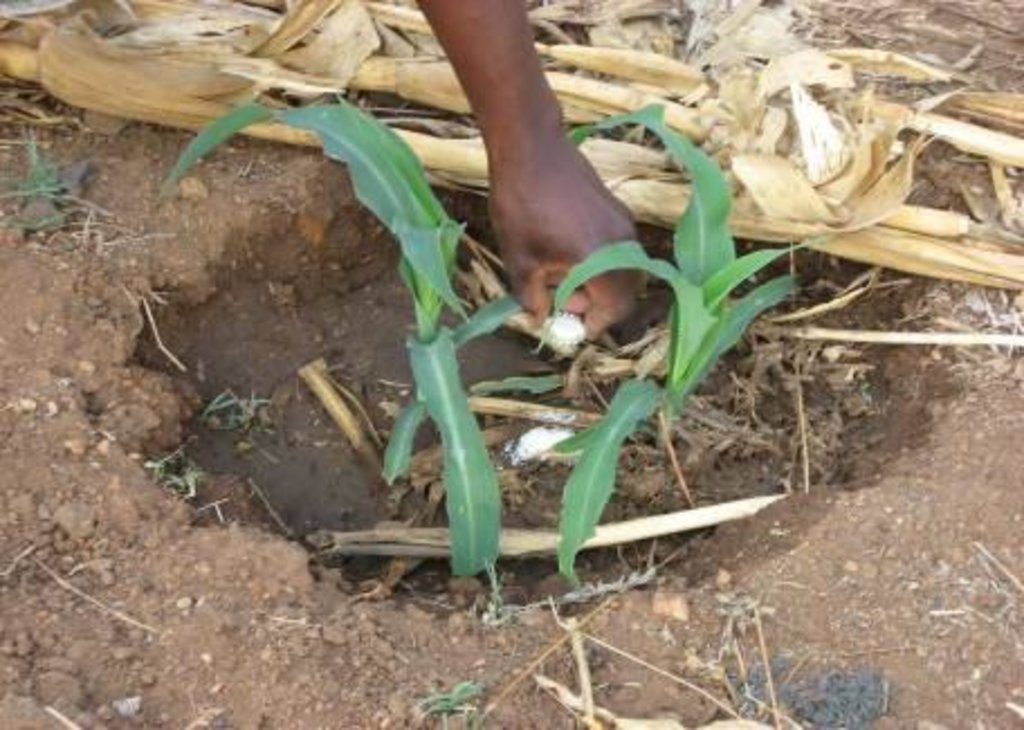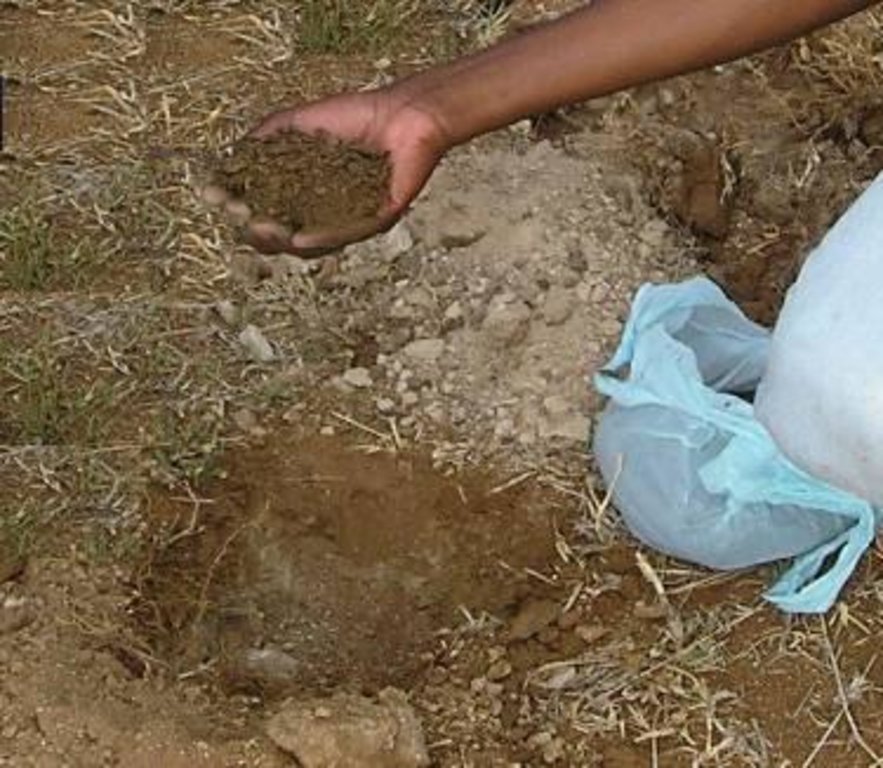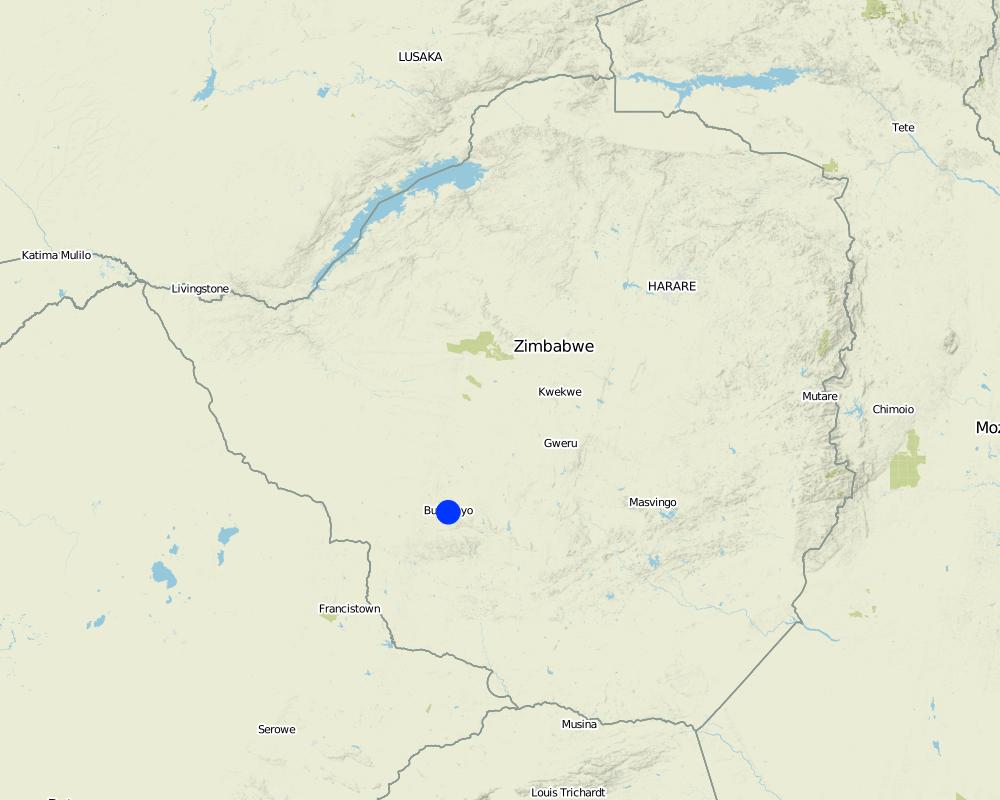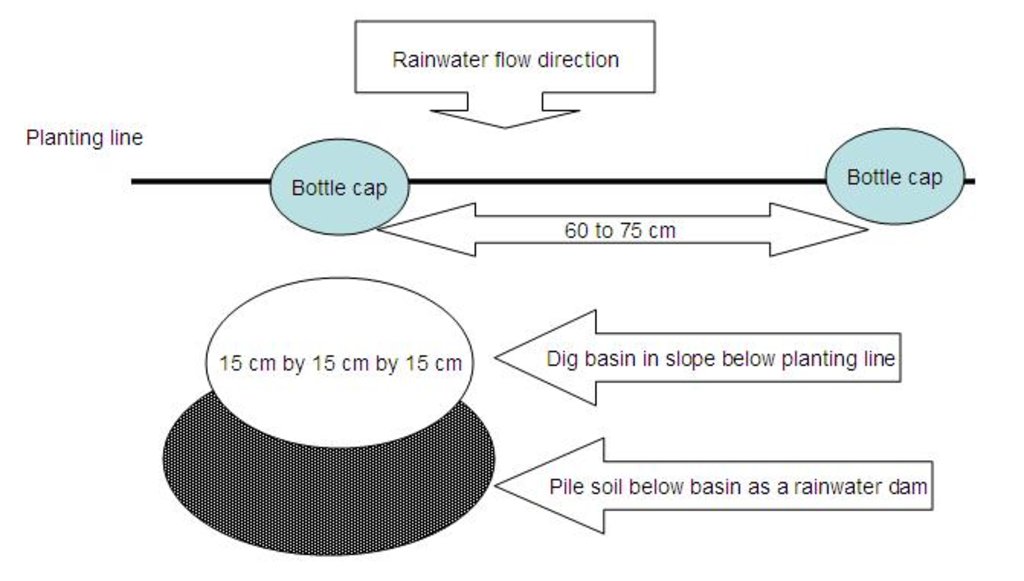Precision Conservation Agriculture [زيمبابوي]
- تاريخ الإنشاء:
- تحديث:
- جامع المعلومات: Stephen Twomlow
- المحرر: –
- المراجعون: Deborah Niggli, Alexandra Gavilano
technologies_1327 - زيمبابوي
عرض الأقسام
توسيع الكل طي الكل1. معلومات عامة
1.2 تفاصيل الاتصال بالأشخاص الرئيسيين لمصدر المعلومات والمؤسسات المشاركة في تقييم وتوثيق التقنية
اسم المشروع الذي سهّل توثيق/تقييم التقنية (إذا كان ذلك على صلة)
Book project: SLM in Practice - Guidelines and Best Practices for Sub-Saharan Africa (SLM in Practice)1.3 الشروط المتعلقة باستخدام البيانات الموثقة من خلال WOCAT
يوافق جامع المعلومات والشخص (لاشخاص) الرئيسي لمصدر المعلومات على الشروط المتعلقة باستخدام البيانات الموثقة من خلال WOCAT:
نعم
1.4 إعلان بشأن استدامة التقنية الموصوفة
هل التقنية الموصوفة هنا تمثل مشكلة فيما يتعلق بتدهور الأراضي، بحيث لا يمكن إعلانها تقنية مستدامة لإدارة الأراضي؟:
كلا
2. وصف تقنيةالإدارة المستدامي للأراضي
2.1 وصف مختصر للتقنية
تعريف التقنية:
Precision Conservation Agriculture combines aspects of conservation agriculture and precision application of fertilizer.
2.2 وصف تفصيلي للتقنية
الوصف:
Precision Conservation Agriculture (PCA) is a combined technology that encompasses four basic principles: 1) minimum tillage – e.g. using planting basins which enhance the capture of water from the first rains and allow efficient application of limited nutrient resources with limited labor input; 2) the precision application of small doses of nitrogen-based fertilizer to achieve higher nutrient efficiency (from organic and/or inorganic sources); 3) combining improved fertility with improved seed for higher productivity; and 4) use of available residues to create a mulch cover that reduces evaporation losses and weed growth. Crop mixes are adapted to the local conditions and household resource constraints. Cereal/legume rotations are desirable. PCA spreads labor for land preparation over the dry seasons and encourages more timely planting, resulting in a reduction of peak labor loads at planting, higher productivity and incomes. Over four years these simple technologies have consistently increased average yields by 50 to 200% in more than 50,000 farm households. These strategies are promoted by ICRISAT, FAO and NGOs in Southern Africa focusing on low potential zones where most of the most resource-poor and vulnerable farm households exist.
Components of CF Planting Basins Package promoted in Zimbabwe:
1. Winter weeding: The first step in preparing a field using CF methods is to remove all weeds. This should be done soon after harvesting in May/June. Weeding is done using implements such as hand hoes and machetes that disturb the soil as little as possible. The importance of weeding before land preparation is to ensure that the plot is weed-free at basin preparation and also to prevent the dispersal of weed seeds.
2. Digging planting basins: Planting basins are holes dug in a weed-free field into which a crop is planted. The basins are prepared in the dry season from July to October. The recommended dimensions of the basin are 15×15×15 cm, spaced at either 75×60 cm for rainfalls of 650 to 900 mm and either 75x75 cm or 90×60 cm for Natural rainfalls of 400 to 650 mm. The basins enable the farmer to plant the crop after the first effective rains when the basins have captured rainwater and drained naturally. Seeds are placed in each basin at the appropriate seeding rate and covered with clod-free soil. The advantage of using basins is that they enhance the capture of water from the first rains of the wet season and enable precision application of both organic and inorganic fertilizer as it is applied directly into the pit and not broadcast.
3. Application of crop residues: Crop residues are applied on the soil surface in the dry season, soon after harvesting if available. Ideally the residues should provide at least 30% soil cover. The mulch buffers the soil against extreme temperatures (thereby reducing soil evaporation), cushions the soil against traffic, and suppresses weeds through shading and improves soil fertility.
4. Application of manure: Fertility amendments are applied soon after land preparation in the dry season. In CF, the application of both organic and inorganic fertilizers is recommended as they complement each other. Organic fertilizers such as manure and/or composts are applied at a rate of at least a handful per planting basin. More can be used in wetter areas.
5. Application of basal fertilizer: Inorganic basal fertilizer is also applied soon after land preparation before the onset of the rains. One level beer bottle cap is applied per planting basin and covered lightly with clod-free soil. This is equivalent to 80 kg of compound fertilizer per hectare. Application rates can be increased in wetter areas and may depend on crop types.
6. Application of topdressing: Nitrogen fertilizer is applied to cereal crops at the 5 to 6 leaf stage soon after the first weeding at a rate of one level beer bottle cap per basin. This is equivalent to 80 kg of ammonium nitrate fertilizer per hectare. Application is done on moist soils. Precision application ensures that the nutrients are available where they are needed. Application rates can be increased in wetter areas and may depend on crop types.
7. Timely weeding: In conventional tillage systems, farmers plough/cultivate repeatedly in order to suppress weeds. With reduced tillage, weeds can be a problem requiring more effort initially. One strategy is to weed in a timely manner (ie, when the weeds are still small) preventing the weeds from setting seed. Timely weeding in combination with mulch should eventually lead to effective weed control.
8. Crop rotation: Rotating crops is one of the key principles of CF. Cereal/legume rotations are desirable because the cereal benefits from nitrogen produced by the Rhizobium associated with the legume, and the legume benefits from the residues produced by the cereal. The advantages of crop rotation include improvement of soil fertility, controlling weeds, pests and diseases, and producing different types of outputs, which reduce the risk of total crop failure in cases of drought and disease outbreaks.
2.3 صور التقنية
2.5 البلد/المنطقة/المواقع التي تم تنفيذ التقنية فيها والتي يغطيها هذا التقييم
البلد:
زيمبابوي
مزيد من التفاصيل حول الموقع:
Bulawayo
Map
×2.6 تاريخ التنفيذ
في حالة عدم معرفة السنة بالتحديد، يرجى الإشارة إلى التاريخ التقريبي:
- منذ أقل من 10 سنوات (مؤخرًا)
2.7 إدخال التقنية
حدد كيف تم إدخال التقنية:
- أثناء التجارب/الأبحاث
3. تصنيف تقنية الإدارة المستدامي للأراضي
3.1 الغرض الرئيسي ( الأغراض الرئيسية) للتقنية
- تحسين الإنتاج
3.2 نوع (أنواع) استخدام الأراضي الحالية حيث يتم تطبيق التقنية

الأراضي الزراعية
- زراعة سنوية
التعليقات:
Major land use problems (land users’ perception): soil fertility decline and reduced organic matter, soil erosion by water, sealing and crusting
3.5 مجموعةالإدارة المستدامة للأراضي التي تنتمي إليها هذه التقنية
- الإدارة المتكاملة لخصوبة التربة
3.6 التدابير التقنية في مجال إلادارة المستدامة للأراضي

التدابير الزراعية
- A1: الغطاء النباتي/التربة
- A2: المادة العضوية/خصوبة التربة
- A3: معالجة سطح التربة
- A4: المعالجة تحت السطحية
- A5: إدارة البذور، الأصناف المحسنة
- A6: إدارة المخلفات
- A7: أخرى
A3: التمييز بين أنظمة الحراثة:
A 3.2: Reduced tillage (> 30% soil cover)

التدابير النباتية
- V5: أخرى

التدابير البنيوية
- S11: غير ذلك

التدابير الإدارية
- M1: التغيير في نوع استخدام الأراضي
- M4: تغيير كبير في توقيت الأنشطة
3.7 الأنواع الرئيسية من تدهور الأراضي التي تناولتها التقنية

تآكل التربة بالمياه
- الوزن(Wt): فقدان التربة السطحية/تآكل السطح

التدهور الكيميائي للتربة
- (Cn): تراجع الخصوبة وانخفاض محتوى المادة العضوية (غير ناتج عن الانجراف)

التدهور المادي أو الفيزيائي للتربة
- (Pk)ظهور وتكون قشرة سطحية
التعليقات:
Secondary causes of degradation: soil management
3.8 منع أو حد أو عكس تدهور الأراضي
تحديد هدف التقنية فيما يتعلق بتدهور الأراضي:
- منع تدهور الأراضي
- الحد من تدهور الأراضي
4. المواصفات الفنية، وأنشطة التنفيذ، والمدخلات، والتكاليف
4.1 الرسم الفني للتقنية
المواصفات الفنية (المتعلقة بالرسم الفني):
Vertical interval and spacing between structures / vegetative strips
Date: 1st November 2009
Technical knowledge required for field staff / advisors: high (Change in attitudes)
Technical knowledge required for land users: high (Change in attitudes)
المؤلف:
Steve Twomlow
4.3 أنشطة التأسيس
| النشاط | التوقيت (الموسم) | |
|---|---|---|
| 1. | 1.Layout of contours with the use of an A-frame before land preparation, place wooden pegs along the contours | during dry season |
4.5 الصيانة/الأنشطة المتكررة
| النشاط | التوقيت/الوتيرة | |
|---|---|---|
| 1. | Direct seeding /fertilizer (NPK) banding using no-till drill | Eearly November |
| 2. | Direct seeding /fertilizer (NPK) banding using no-till drill | Eearly November |
| 3. | Leave fields to fallow for 18 months, apply herbicide if needed | afther harvest |
| 4. | Leave fields to fallow for 18 months, apply herbicide if needed | afther harvest |
4.6 التكاليف والمدخلات اللازمة للصيانة/للأنشطة المتكررة (سنويًا)
| تحديد المدخلات | الوحدة | الكمية | التكاليف لكل وحدة | إجمالي التكاليف لكل مدخل | % من التكاليف التي يتحملها مستخدمو الأراضي | |
|---|---|---|---|---|---|---|
| العمالة | labour | ha | 1,0 | 108,0 | 108,0 | |
| معدات | hand hoes | ha | 1,0 | 7,0 | 7,0 | |
| الأسمدة والمبيدات الحيوية | fertilizer | ha | 1,0 | 69,0 | 69,0 | |
| إجمالي تكاليف صيانة التقنية | 184,0 | |||||
| إجمالي تكاليف صيانة التقنية بالدولار الأمريكي | 184,0 | |||||
5. البيئة الطبيعية والبشرية
5.1 المناخ
هطول الأمطار السنوي
- < 250 مم
- 251- 500 ملم
- 501 - 750ملم
- 1,000-751 ملم
- 1,500-1,100 ملم
- 2,000-1,500 ملم
- 3,000-2,001 ملم
- 4,000-3,100 ملم
- > 4000 ملم
المواصفات/التعليقات على هطول الأمطار:
Summer rains October/November to March 79 to 179 days
المنطقة المناخية الزراعية
- شبه قاحلة
- قاحلة
5.2 طوبوغرافيا
متوسط الانحدارات:
- مسطح (0-2%)
- بسيط (3-5%)
- معتدل (6-10%)
- متدحرج (11-15%)
- تلال (16-30%)
- شديدة الانحدار(31-60%)
- فائقة الانحدار (>60%)
التضاريس:
- هضاب/سهول
- أثلام مرتفعة
- المنحدرات الجبلية
- منحدرات التلال
- منحدرات في السفوح
- قاع الوادي
المنطقة الارتفاعية:
- 100-0 متر فوق سطح البحر
- 500-101 متر فوق سطح البحر
- 1,000-501 متر فوق سطح البحر
- 1,500-1,001 متر فوق سطح البحر
- 2,000-1,501 متر فوق سطح البحر
- 2,500-2,100 متر فوق سطح البحر
- 3,000-2,501 متر فوق سطح البحر
- 4,000-3,001 متر فوق سطح البحر
- > 4000 متر فوق سطح البحر
5.3 التربة
متوسط عمق التربة:
- ضحل جدًا (0-20 سم)
- ضحلة (21-50 سم)
- متوسطة العمق (51-80 سم)
- عميقة (81-120 سم)
- عميقة جدًا (> 120 سم)
المواد العضوية في التربة السطحية:
- منخفضة (<1%)
5.6 خصائص مستخدمي الأراضي الذين يطبقون التقنية
التوجه السوقي لنظام الإنتاج:
- الكفاف (الإمداد الذاتي)
المستوى النسبي للثروة:
- ضعيف
- متوسط
أفراداً أو مجموعات:
- فرد/أسرة معيشية
مستوى المكننة:
- عمل يدوي
- الجر الحيواني
اذكر الخصائص الأخرى ذات الصلة لمستخدمي الأراضي:
Land users applying the Technology are mainly common / average land users
Population density: 10-50 persons/km2
5.7 متوسط مساحة الأرض التي يستخدمها مستخدمو الأراضي الذين يطبقون التقنية
- < 0.5 هكتارا
- 0.5 - 1 هكتار
- 1 -2 هكتار
- 2 - 5 هكتار
- 5 - 15 هكتار
- 15 - 50 هكتار
- 50 - 100هكتار
- 500-100 هكتار
- 1,000-500 هكتار
- 10,000-1,000 هكتار
- > 10,000 هكتار
هل يعتبر هذا نطاقًا صغيرًا أو متوسطًا أو واسعا (في إشارة إلى السياق المحلي)؟:
- على نطاق صغير
5.8 ملكية الأراضي، وحقوق استخدام الأراضي، وحقوق استخدام المياه
ملكية الارض:
- مجتمعي/قروي
6. الآثار والتصريحات الختامية
6.1 الآثار التي أظهرتها التقنية في الموقع
الآثار الاجتماعية والاقتصادية
الإنتاج
إنتاج المحاصيل
الكمية قبل الإدارة المستدامة للأراضي:
400 kg/ha
الكمية بعد الإدارة المستدامة للأراضي:
1520 kg/ha
التعليقات/ حدد:
increase varies between 50-200%, depending on rainfall regime, soil types and fertility, and market access
إنتاج الأعلاف
الكمية قبل الإدارة المستدامة للأراضي:
600 kg/ha
الكمية بعد الإدارة المستدامة للأراضي:
2200 kg/ha
جودة العلف
خطر فشل الإنتاج
تنوع المنتج
إدارة الأراضي
الدخل والتكاليف
دخل المزرعة
الآثار الاجتماعية والثقافية
الأمن الغذائي / الاكتفاء الذاتي
الكمية قبل الإدارة المستدامة للأراضي:
1.8 ha
الكمية بعد الإدارة المستدامة للأراضي:
0.6 ha
التعليقات/ حدد:
Household meets food needs from less land
الفرص الثقافية
المؤسسات المجتمعية
التعليقات/ حدد:
Community work groups using establishment
المعرفة بالإدارة المستدامة للأراضي/تدهور الأراضي
وضع الفئات المحرومة اجتماعيا واقتصاديا
الآثار الايكولوجية
دورة المياه / الجريان السطحي
جودة المياه
التعليقات/ حدد:
Dependent on number adopting in community/catchment
حصاد / جمع المياه
الجريان السطحي
التبخر
التربة
رطوبة التربة
غطاء التربة
فقدان التربة
تكون قشرة التربة السطحية/انسداد مسام التربة
تراص التربة
دورة المغذيات/إعادة الشحن
المادة العضوية في التربة/تحت الطبقة c
التنوع البيولوجي: الغطاء النباتي، الحيوانات
الكتلة الحيوية/ طبقة الكربون فوق التربة
الأنواع المفيدة
الحد من مخاطر المناخ والكوارث
انبعاث الكربون والغازات المسببة للاحتباس الحراري
6.3 تعرض التقنية وحساسيتها لتغير المناخ التدريجي والظواهر المتطرفة/الكوارث المرتبطة بالمناخ (كما يراها مستخدمو الأراضي)
تغير مناخ تدريجي
تغير مناخ تدريجي
| الموسم | زيادة أو نقصان | كيف تتعامل التقنية مع ذلك؟ | |
|---|---|---|---|
| درجة الحرارة السنوية | زيادة | جيدا |
الظواهر المتطرفة / الكوارث المرتبطة بالمناخ
الكوارث الجوية
| كيف تتعامل التقنية مع ذلك؟ | |
|---|---|
| عاصفة ممطرة محلية | غير معروف |
الكوارث المناخية
| كيف تتعامل التقنية مع ذلك؟ | |
|---|---|
| جفاف | جيدا |
العواقب الأخرى المتعلقة بالمناخ
العواقب الأخرى المتعلقة بالمناخ
| كيف تتعامل التقنية مع ذلك؟ | |
|---|---|
| انخفاض فترة النمو | جيدا |
6.4 تحليل التكلفة والعائد
كيف يمكن مقارنة العوائد نسبة لتكاليف الإنشاء (من وجهة نظر مستخدمي الأراضي)؟
عوائد قصيرة الأجل:
إيجابي
عوائد طويلة الأجل:
ايجابي جدا
كيف تتم مقارنة العوائدمع كلفة الصيانة/التكاليف المتكررة (من وجهة نظر مستخدمي الأراضي)؟
عوائد قصيرة الأجل:
إيجابي
عوائد طويلة الأجل:
ايجابي جدا
6.5 اعتماد التقنية
التعليقات:
50000 land user families have adopted the Technology with external material support
0.3 had under basins in 2008 – so about 15,000 ha across Zimbabwe
There is a strong trend towards spontaneous adoption of the Technology
Over the last 4 years a steady trend in increase in area each household as under basins
6.7 نقاط القوة / المزايا / الفرص التي توفرها التقنية
| نقاط القوة/ المزايا/ الفرص من وجهة نظر جامع المعلومات أو غيره من الاشخاص الرئيسيين لمصدر المعلومات |
|---|
| PCA spreads labour for land preparation over the dry season and encourages more timely planting, resulting in a reduction of peak labour loads at planting, higher productivity and incomes |
| Over four years these simple technologies have consistently increased average yields by 50 to 200%, depending on rainfall regime, soil types and fertility, and market access |
6.8 نقاط ضعف / مساوىء / مخاطر التقنية وسبل التغلب عليها
| نقاط الضعف/ المساوىء/ المخاطر من وجهة نظر جامع المعلومات أو غيره من الاشخاص الرئيسيين لمصدر المعلومات | كيف يمكن التغلب عليها؟ |
|---|---|
| Availability of residues to achieve the minimum 30% soil cover | Accept that in agro-pastoral systems where residues are at a premium demonstrate benefits of residues management – but allow households to decide |
| Access to fertilizer at cost effective prices | Input market development and identification of enabling government policies |
| Rotations and legumes poorly adopted | Allow households to become familiar with technology and meet subsistence food requirements before promoting rotations. Ensure availability of good quality seeds and markets to meet extra legume production |
7. المراجع والروابط
7.1 طرق جمع/مصادر المعلومات
- زيارات ميدانية، مسوحات ميدانية
- مقابلات مع مستخدمي الأراضي
7.2 المراجع للمنشورات المتاحة
العنوان، المؤلف، السنة، النظام القياسي الدولي لترقيم الكتب ISBN:
Hove L, Twomlow S. 2008. Is conservation agriculture an option for vulnerable households in Southern Africa? Paper presented at the Conservation Agriculture for Sustainable Land Management to Improve the Livelihood of People in Dry Areas Workshop, United
متاح من أين؟كم التكلفة؟:
ICRISAT web site – www.icrisat.org or FAO
العنوان، المؤلف، السنة، النظام القياسي الدولي لترقيم الكتب ISBN:
Mazvimavi K, Twomlow S, Belder P, Hove L. 2007. An Assessment of the Sustainable Uptake of CF in Zimbabwe. Global Theme on Agroecosystems Report No 39. ICRISAT, Bulawayo. 69pp.
متاح من أين؟كم التكلفة؟:
ICRISAT – www.icrisat.org
العنوان، المؤلف، السنة، النظام القياسي الدولي لترقيم الكتب ISBN:
Mazvimavi, K., Twomlow, S. Socioeconomic and institutional factors influencing adoption of conservation farming by vulnerable households in Zimbabwe. Agr. Syst. (2009), doi:10.1016/j.agsy.2009.02.002
متاح من أين؟كم التكلفة؟:
Elsevier – Agricultural Systems
العنوان، المؤلف، السنة، النظام القياسي الدولي لترقيم الكتب ISBN:
Twomlow,S., Hove, L., Mupangwa, W., Masikati, P., Mashingaidze,N. 2009. Precision Conservation Agriculture For Vulnerable Farmers In Low-Potential Zones In Humphreys, E. and Bayot, R.S. (Editors). 2009. Increasing the productivity and sustainability of r
متاح من أين؟كم التكلفة؟:
xxx
العنوان، المؤلف، السنة، النظام القياسي الدولي لترقيم الكتب ISBN:
Zimbabwe Conservation Agriculture Task Force, 2009. Farming for the future: A guide to conservation agriculture in Zimbabwe. ISBN 978-07974-3735-7
متاح من أين؟كم التكلفة؟:
FAO Emergency Office Zimbabwe Michael.jenrich@fao.org
الروابط والوحدات المواضيعية
توسيع الكل طي الكلالروابط
لا يوجد روابط
الوحدات المواضيعية
لا يوجد وحدات مواضيعية


